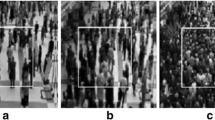Abstract
As a particular class of public security issues, the large-scale crowd analysis plays a very important role in video surveillance application. This paper proposes a sparse spatial-temporal local binary pattern (SST-LBP) descriptor to extract dynamic texture of the walking crowd which can be applied to the crowd density estimation and distribution analysis. The proposed approach consists of four steps. First of all, sparse selected locations are extracted, which vary notably in both spatial domain and temporal domain. Afterwards, we propose a SST-LBP algorithm to extract the local dynamic feature and utilize the local feature’s statistical property to describe the crowd feature. Thirdly, the overall crowd density level can be determined by classifying the crowd feature with support vector machine. Finally, the local feature is used to represent the local density and then the overall density distribution can be described. To improve the accuracy, we introduce the perspective correction into the detection of sparse selected locations and the spectrum analysis of SST-LBP code. The experiments on different datasets not only show that the proposed SST-LBP method is effective and robust on the large-scale crowd density estimation and distribution, but also indicate that the deformity correction is useful. Compared with other methods, the proposed method has the advantage of low computation complexity and high efficiency. In addition, it performs well on all density levels and can present local crowd distribution.
















Similar content being viewed by others
References
Beran V, Hradis M, Zemcik P et al (2008) Video summarization at Brno university of technology. Proceeding of the 2nd ACM workshop on Video summarization, pp. 31–34
Chan AB, Vasconcelos N (2012) Counting people with low-level features and Bayesian regression. IEEE Trans Image Process 21(4):2160–2177
Chan AB, Liang Z-SJ, Vasconcelos N (2008) Privacy preserving crowd monitoring: counting people without people models or tracking. IEEE Conference on Computer Vision and Pattern Recognition, pp. 1–7
Chapelle O, Haffner P, Vapnik VN (1999) Support vector machines for histogram-based image classification. IEEE Trans Neural Netw 10(5):1055–1064
Chetverikov D, Peteri R (2005) A brief survey of dynamic texture description and recognition. Adv Soft Comput 30:17–26
Cho S-Y, Chow TWS, Leung C-T (1999) A neural-based crowd estimation by hybrid global learning algorithm. IEEE Trans Syst Man Cybern B Cybern 29:535–541
Davies AC, Yin JH, Velastin SA (1995) Crowd monitoring using image processing. Electron Comm Eng J 7(1):37–47
Ge W, Collins RT (2010) Crowd density analysis with marked point processes [applications corner]. IEEE Signal Process Mag 27(5):107–123
Huang D, Chow TWS (2003) A people-counting system using a hybrid RBF neural network. Neural Process Lett 18(2):97–113
Kreßel UH-G (1999) Pairwise classification and support vector machines. Advances in kernel methods: support vector learning, pp. 255–268
Lempitsky V, Zisserman A (2010) Learning to count objects in images. Machine Vision Learning/Statistics & Optimisation
Lin S-F, Chen J-Y, Chao H-X (2001) Estimation of number of people in crowded scenes using perspective transformation. IEEE Trans Syst Man Cybern Syst Hum 31(6):645–654
Ma R, Li L, Huang W, Tian Q (2004) On pixel count based crowd density estimation for visual surveillance. Cybernetics and Intelligent Systems, 2004 IEEE Conference 1:170–173
Marana AN, Verona V (2001) Wavelet packet analysis for crowd density estimation, Proceedings of the IASTED International Symposia on Applied Informatics, pp. 535–540
Marana AN, Velastin SA, Costa L et al (1998) Automatic estimation of crowd density using texture. Saf Sci 28:165–175
Marana AN, Da Fontoura Costa L, Lotufo RA, Velastin SA (1999) Estimating crowd density with Minkowski fractal dimension. Acoust Speech Signal Process 6:3521–3524
Mikolajczyk K, Tuytelaars T, Schmid C et al (2005) A comparison of affine region detectors. Int J Comput Vis 1–2(65):43–72
Ojala T, Pietikainen M, Maenpaa T (2002) Multiresolution gray-scale and rotation invariant texture classification with local binary patterns. IEEE Trans Pattern Anal Mach Intell 24(7):971–987
Polus A, Schofer JL, Ushpiz A (1983) Pedestrian flow and level of service. J Transport Eng 109(1):46–56
Rodriguez M, Laptev I, Sivic J et al (2011) Density-aware person detection and tracking in crowds. 2011 IEEE International Conference on Computer Vision (ICCV), pp. 2423–2430
Roqueiro, Petrushin VA (2007) Counting people using video cameras. International Journal of Parallel, Emergent and Distributed Systems 22(3):193–209
Sen G, Liu Wei, Yan He Ping (2009) Counting people in crowd open scene based on grey level dependence matrix. International Conference on Information and Automation, pp. 228–231
Su H, Yang H, Zheng S (2011) The large-scale crowd density estimation based on effective region feature extraction method. Lect Notes Comput Sci 6494:302–313
Wu X, Liang G, Lee KK et al (2006) Crowd density estimation using texture analysis and learning. IEEE International Conference on Robotics and Biomimetic, pp. 214–219
Yang H, Su H, Zheng S (2011) The Large-scale Crowd Density Estimation Based on Sparse Spatio-temporal Local Binary Pattern, IEEE International Conference on Multimedia and Expo (ICME), pp. 1–6
Zhao G, Pietikainen M (2007) Dynamic texture recognition using local binary patterns with an application to facial expressions. IEEE Trans Pattern Anal Mach Intell 29(6):915–928
Acknowledgments
This research is partly supported by NSFC (No.61102099, No.61171172), Scientific and Technological Committee of Shanghai (No.11231203102, No.10231204002) and National Basic Research Program (973 Program, No. 2010CB731406). We sincerely thank for the testing video datasets from University of Reading and permission (PETS2009) and University of Minnesota.
Author information
Authors and Affiliations
Corresponding author
Rights and permissions
About this article
Cite this article
Yang, H., Cao, Y., Su, H. et al. The large-scale crowd analysis based on sparse spatial-temporal local binary pattern. Multimed Tools Appl 73, 41–60 (2014). https://doi.org/10.1007/s11042-012-1264-0
Published:
Issue Date:
DOI: https://doi.org/10.1007/s11042-012-1264-0




